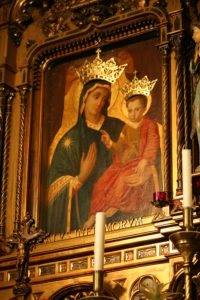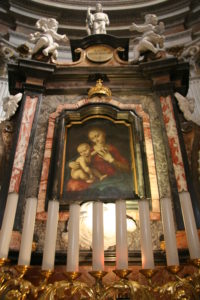 “There is no greater love than that of a mother for her only sick child”, is for us the maximum parameter that can be expressed. The Prophet Isaiah uses it to make us understand love of God for us: “Does a woman forget her child?… Just as a mother consoles a child so I will console you, in Jerusalem you will be consoled…” (49, 15; 66, 13).
“There is no greater love than that of a mother for her only sick child”, is for us the maximum parameter that can be expressed. The Prophet Isaiah uses it to make us understand love of God for us: “Does a woman forget her child?… Just as a mother consoles a child so I will console you, in Jerusalem you will be consoled…” (49, 15; 66, 13).
Saint Camillus also prescribed it as a parameter when he wanted to express in synthesis the love that the nascent Congregation should put as the foundation of its being next to the bed of the sick.
And this was well understood by the faithful of the love that the Immaculate Mother of God has for the children entrusted to her (Jn 19:25-27), brothers and sisters of her Son, “the firstborn of many brothers”. (Rom 8:29), invoking her as Salus Infirmorum (Health of the Sick)
The Second Vatican Council implicitly presents her as follows: “With her maternal charity she takes care of her Son’s brothers and sisters who still journey of earth surrounded by dangers and distress. For this reason the Blessed Virgin is invoked in the Church with the titles of Advocate, Help of Christians, Mediatrix” (Lumen Gentium, 62).
We are fully aware of our state of “infirmitas” (sickness), and not only at levels of organic or psychophysical dysfunction, but also at the moral level which generates deeper suffering and which is not easily removable, because it is inherent in that sphere of existence which is part of the spiritual dimension of the creature, and which for us believers is called the soul. And the “pain of the soul”, as John Paul II writes, is less reachable by therapy, whose vastness and multiform sufferings are certainly not less than the physical one (cf. Salvifici Doloris, 5).
It is the attentive tenderness of the Mother that attracts us and fills us with hope, and leads us to total entrustment to Her, the Health of the Sick, for the integral recovery of health, because we feel that “death” (Genesis 2:17), a consequence of our ancestors’ sin of pride and disobedience to God, weighs on our existence. But she, the Immaculate Mother of God, “assumed into heaven did not lay down this function of salvation, but with her multiple intercession continues to obtain for us the graces of eternal health” (LG, 62).
In the Gospel
The Gospels present to us Jesus as the One who heals and proclaims the Kingdom. It is his qualification. To John the Baptist in prison he sends to say: “Go and tell what you hear and see: the blind see, the crippled walk, the lepers are cleansed, the deaf hear, the dead are raised up, and the poor have good news preached to them. And blessed is he who takes no offence at me” (Mt 11:4-6).
From the very first mission as his envoys, he gave his disciples “the power to drive out unclean spirits and to heal all sorts of illnesses and infirmities… and on the way preach that the Kingdom of heaven is at hand” (Mt 10:1 and 7). The Gospels do not tell us that a similar mandate has been given to his Immaculate Mother, nor that she has made any healing like the Disciples. Yet we are told of her irreplaceable role which began “when the fullness of time came (and) God sent his Son, born of a woman, born under the law, to redeem those who were under the law, so that we might receive adoption as children” (Gal 4:4-5).
The Second Vatican Council proclaimed that “this union of the Mother with the Son in the work of salvation is made manifest from the time of Christ’s virginal conception up to His death; it is shown first of all when Mary, arising in haste to go to visit Elizabeth, is greeted by her as blessed because of her belief in the promise of salvation and the precursor leaped with joy in the womb of his mother” (LG, 57).
If we read the Holy Gospels well, there are two moments that tell us about the Blessed Virgin Mary’s role as Salus Infirmorum: from the first moment of the nascent life of a human creature – the Precursor – to that of the death of her Son in a cruel and unjust way decreed by perverse men.














Camillians on Facebook
Camillians on Twitter
Camillians on Instagram